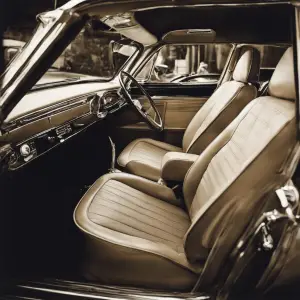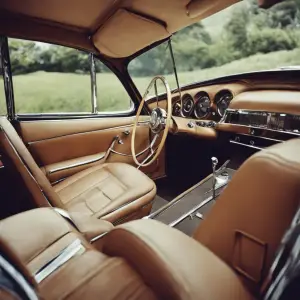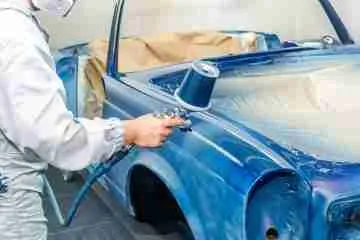Interior Car Care 101: How to Make Your Car’s Interior Last

Interior Car Care 101: How to Make Your Car’s Interior Last
So you’ve got a sweet ride and want to keep that new car smell for as long as possible. Or maybe your car’s interior has seen better days and is due for some freshening up. Either way, keeping your car’s interior looking and smelling like new is easier than you think. With some simple tricks for cleaning, conditioning, and protecting, you’ll be cruising in comfort and style for years to come.
In this guide, we’ll walk you through the basics of interior car care from floors to ceilings and everything in between. You’ll learn professional tips for vacuuming and shampooing seats, conditioning leather and vinyl, wiping down plastics, and eliminating odors. We’ll also show you the best products and tools to stock in your garage so you’ll be ready to detail like a pro. Follow these steps and your car’s interior will stay showroom fresh for the long haul. So sit back, get ready to clean, and enjoy the ride. Your clean and cozy cabin awaits!
Why Interior Car Care Matters
Why Interior Car Care Matters
- Your car’s interior takes a beating over time. Between dirt, spills, sun damage, and regular wear and tear, the inside of your vehicle can start to look pretty rough if you don’t stay on top of caring for it.
- Protecting your interior now means your car will have a higher resale value down the road. Keeping your seats, carpets, dashboard and trim in like-new condition makes a great first impression on potential buyers.
- A clean, well-maintained interior also means a safer, more pleasant driving experience for you and your passengers. Dirty, stained upholstery and a messy cabin filled with clutter is distracting and off-putting.
Do a Deep Clean
About once a month, do a deep clean of your interior. Vacuum seats and carpets, wipe down vinyl and plastic parts with an all-purpose cleaner or degreaser and a microfiber cloth. Use a toothbrush or soft bristled brush to get into vents, crevices and air conditioning grills. Be sure to clean door jambs, too – that’s an area that’s often overlooked!
Protect and Condition
Apply a UV protectant to your dashboard, vinyl seats and trim to guard against sun damage. Use a conditioner or protectant on leather seats to keep them supple and prevent cracking. Reapply as directed.
Address Stains Promptly
Treat any stains immediately before they have time to set in. Keep a stain remover, wipes and cleaning cloths in your car for quick action. Blot at any spills, rather than rubbing them in. For tough protein stains like blood, use a commercial stain remover and cool water. Heat will only make protein stains harder to remove.
Keeping your interior in tip-top shape requires some effort, but the reward of a pristine cabin and higher resale value down the road make it well worth it. With regular cleaning, conditioning and stain removal, your car’s interior will look like new for years to come.
Cleaning Your Car’s Interior: Supplies You’ll Need
To keep your car’s interior looking like new, you’ll need some essential supplies.
Vacuum
A good vacuum designed for cars with appropriate attachments is a must. Look for one with a hose extension so you can reach tight areas and a brush attachment for vents and upholstery.
Carpet cleaner
For stubborn stains on carpets, floor mats and upholstery, use a dedicated car carpet cleaner or a mixture of water and white vinegar or dish soap. Blot with a clean, damp rag and let air dry.
Seat covers
Seat covers protect seats from spills, stains, and damage. Look for breathable covers that won’t make you sweat in the summer. Washable covers are also convenient since you can just throw them in the wash.
Microfiber cloths
Microfiber cloths are very effective at trapping dirt and dust. Use them to wipe down vinyl, plastic and leather surfaces in your car’s interior.
Air freshener
Choose an air freshener with a scent you enjoy to keep your car smelling fresh. Look for natural essential oil diffusers, scented beads or clips that attach to air vents. Avoid heavily fragranced sprays which can leave residue on surfaces.
Rubbing alcohol
Isopropyl rubbing alcohol is great for wiping down and disinfecting hard interior surfaces like the dashboard, center console and door panels. It cuts through grease and grime and leaves your car smelling clean.
With the proper supplies and some elbow grease, you’ll have your car’s interior looking showroom new again in no time. Keep your ride fresh and you’ll enjoy it for years to come!
Vacuuming and Shampooing Carpet and Upholstery
Vacuuming and shampooing your car’s carpet and upholstery regularly is key to keeping the interior looking like new. Dirt and debris can build up over time, wearing down fibers and dulling the appearance. Following these tips will help you give your car’s interior a deep clean.
Vacuum thoroughly
Use a vacuum with strong suction and various attachments to reach every nook and cranny. Vacuum seats, carpeting, floor mats, trunk, and any other upholstered areas. Remove floor mats and vacuum underneath them. Use crevice tools to vacuum along edges, seams and trim. For stubborn dirt, use short repeated strokes.
• Pay extra attention to high-traffic areas where dirt collects like footwells, center console and door pockets.
Consider shampooing
If your carpeting or upholstery looks dingy even after vacuuming, shampooing can brighten and refresh. Use a foam shampoo designed specifically for automotive use. Follow directions carefully, working in small sections at a time. Rinse and extract thoroughly with water to avoid mildew growth. Let air dry completely.
• For spot stains, pretreat before shampooing and consider using a portable carpet cleaning machine.
• Shampooing cloth seats requires extra care. Check if it’s safe for your specific upholstery before proceeding. If unsure, consult a professional.
• Shampoo at least once a year or if there are odors in the vehicle.
Additional tips
• Clean vents and air filters to improve circulation and reduce mustiness.
• Wipe down vinyl and plastic parts like the dashboard, center console, door panels, and trim. Use a damp microfiber cloth with an all-purpose cleaner or vinyl protectant.
• Remove trash, clutter and any items under seats to make vacuuming and cleaning more effective.
• For tough odors, you may need to steam clean, ozone treat or replace air filters.
• Consider professional detailing for a deep, top-to-bottom clean at least every couple of years.
By regularly vacuuming, shampooing when needed and following these additional tips, you’ll keep your vehicle’s interior looking and smelling fresh for the long haul. Your car is a big investment, so taking good care of the inside is well worth the effort.
Wiping Down and Polishing Dashboard and Trim
Keeping your car’s interior clean and protected will help it look its best and last longer. An important part of interior car care is regularly wiping down and polishing the dashboard and trim.
Dashboard and Trim
The dashboard and trim, like door panels and center console, endure a lot of wear and tear and exposure to UV damage. Giving them some TLC will prevent cracking and fading.
About once a month, wipe down the dashboard and all trim with a microfiber cloth to remove built-up dust and debris. For stuck-on grime, use an interior cleaner or degreaser and scrub gently with an old toothbrush or soft bristled cleaning brush. Be sure to vacuum air vents and crevices as well where dust collects.
Every few months, polish and protect the dashboard and trim with a UV-protectant polish or vinyl/plastic restorer. Apply with a soft cloth, rubbing in small circular motions. Let it soak in for a few minutes, then buff off excess with another clean cloth. These products fill in tiny scratches and pores, leaving behind a protective coating and shine. They also contain UV blockers to prevent sun damage.
Conditioners and polishes containing natural oils like jojoba or beeswax are especially effective for conditioning and protecting vinyl and plastics. They moisturize, soften and leave behind a durable yet matte finish. For a glossy finish, use a product intended specifically for dashboards and trim.
A little elbow grease now will pay off down the road in preventing a dull, cracked dashboard and trim. Keep your car’s interior looking showroom new with regular wipe downs, polishing and protection. Maintaining your vehicle’s interior will help ensure many more miles of enjoyment from your ride.
Cleaning Interior Glass and Mirrors
Keeping your car’s interior glass clean makes a big difference in your driving experience and safety. Dirty or foggy windows can be dangerous by limiting your visibility. Take the time to clean your windshield, windows, mirrors, and any other glass surfaces in your vehicle regularly.
Supplies You’ll Need
You’ll want to gather:
- Glass cleaner (ammonia-free)
- Microfiber cloths, towels or mitts
- Paper towels (optional)
- Dusting brush (for vents and crevices)
Cleaning the Windshield and Windows
Spray your glass cleaner onto the windshield and windows and use a microfiber cloth, towel or mitt to wipe clean in circular motions. Start with the top and work your way down using vertical and horizontal strokes. Use a dusting brush to get into any vents or crevices. For stubborn stuck-on messes, let the cleaner soak in for a few minutes before wiping away.
Cleaning Mirrors
Spray glass cleaner onto your mirrors and wipe clean with microfiber, using the same circular rubbing motion and working from top to bottom. For rearview mirrors, spray the cleaner onto the microfiber itself to avoid overspray into the mirror casing. Make sure all mirrors are streak-free for maximum visibility.
Additional Tips
- Vacuum seats, carpets, door panels and any trim before cleaning glass to remove loose dirt and debris.
- For foggy windows, run the heater and air conditioner to help reduce condensation before cleaning the glass.
- Consider using a plastic scraper or razor blade to remove any stuck-on decals or paint from windows before cleaning.
- For stubborn hard water spots or mineral stains on glass, make a paste from baking soda and water and scrub gently with an abrasive sponge or scrubber.
Keeping your interior glass clean is key to safe driving and maintaining your vehicle. Following these tips and techniques will have your windshield, windows and mirrors crystal clear in no time.
Conditioning Leather Seats and Steering Wheel
Leather seats and steering wheels require regular conditioning to keep them soft, supple and looking their best. Neglecting them can lead to drying, cracking and premature aging.
Cleaning
About once a month, wipe down your leather seats and steering wheel with a damp, lint-free cloth to remove dirt and grime. For stubborn stains, make a solution of warm water and a mild detergent or leather cleaner. Gently blot with the solution and wipe away. Avoid scrubbing too hard, which can damage the leather. Rinse well with water and pat dry with another soft cloth.
Conditioning
Condition your leather seats and steering wheel every 3-6 months to replenish moisture and oils. Use a high-quality leather conditioner or balm and follow the directions on the product. In general:
- Apply the conditioner with a soft cloth, rubbing it into the leather using small circular motions.
- Pay extra attention to high-contact areas like seat bolsters, center seat sections and the sides/underside of the steering wheel.
- Let the conditioner soak in for at least 30 minutes or as directed.
- Buff away any excess with a clean, soft cloth.
- For heavily soiled or dried-out leather, you may need to condition more frequently. It’s a good idea to do a deep conditioning treatment once a year.
Protection
As an optional extra step, you can apply a leather protectant spray, especially to high-traffic areas. The protectant will help shield from stains and make the leather more water-resistant. Reapply the protectant every 3-6 months as well, or sooner if water no longer beads up on the surface.
By regularly cleaning, conditioning and protecting your leather interior, you’ll keep your seats and steering wheel soft to the touch and looking like new for years to come. Your vehicle’s interior will thank you for the pampering and last far into the future.
Removing Odors and Air Freshening Tips
Removing odors and freshening the air in your vehicle is important for comfort and resale value. Here are some tips to help your car’s interior smell fresh and clean:
Baking soda
Baking soda is a natural odor absorber. Place open containers of baking soda in your car, especially under the seats. Change them every 30 days or so. You can also make DIY air fresheners by filling mesh bags or old stockings with baking soda and tying off the end. Hang them from your rearview mirror or place in cup holders.
Essential oils
Add a few drops of essential oils like lemon, lavender or peppermint to a spray bottle filled with water. Shake to combine and spray in your car as needed. The natural fragrances will help neutralize odors. You can also put a few drops of essential oil on cotton balls and place them in your air vents.
Vacuum and shampoo
Vacuuming your seats and carpets regularly removes dirt, food crumbs and other debris that can build up and cause musty smells. For stubborn odors, rent an upholstery cleaner or carpet shampooer. Shampooing your seats, floor mats and carpeting will leave your interior smelling fresh. Let all areas dry completely to avoid mold growth.
Air out
When possible, open your windows to allow fresh air to circulate in the vehicle. This can help remove built-up odors from smoking, food or the environment. For the best results, open windows on opposite sides of the vehicle to create airflow.
Commercial air fresheners
If natural solutions are not effective, you can try commercial air fresheners. Look for fresheners labeled “odor eliminating” or “odor neutralizing” rather than those that just mask smells. Place them in your air vents or under seats, following directions on the product. Be sure to check that any air freshener product you use is specifically intended for automotive use to avoid potential damage to surfaces in the vehicle.
With regular attention, you can keep your vehicle’s interior smelling fresh and looking like new. Simple steps like baking soda, essential oils and vacuuming go a long way toward odor elimination and creating an enjoyable driving environment.
Stain Removal for Carpet and Upholstery
Stains happen, especially in a vehicle interior where spills and splatters are common. The key to removing stains from your car’s carpet and upholstery is to treat them as soon as possible. The longer a stain sets in, the harder it will be to remove.
First, try blotting at any fresh spill with a clean, damp cloth to absorb as much of the stain as possible. For dried-on stains, scrape off any excess residue with a blunt knife or spoon. Mix up a solution of one tablespoon of dish soap, one tablespoon of white vinegar, and two cups of warm water. Use an old towel to apply the solution directly to the stain and blot until the stain is lifted. Let the area air dry completely. You may need to repeat this process a few times for tough stains.
For protein stains like milk, eggs, or blood, use a mixture of detergent and hydrogen peroxide or ammonia. The oxygen bubbles help lift the stain from the fibers. Blot with a damp cloth and let air dry.
Grease and oil stains require a degreaser like Goo Gone or WD-40. Spray it on, let it sit for a few minutes and then blot with a cloth to absorb the stain. You may need to repeat a few times. Rinse well with water and let dry.
For stubborn stains, you can rent an upholstery cleaner or carpet cleaning machine. Be sure to test any product in an inconspicuous area first to check for colorfastness. As a last resort for persistent stains, you can try using a commercial stain remover product, available at most auto parts stores.
With regular and prompt treatment, you can eliminate most stains from your vehicle’s interior and keep it looking like new. Be patient and don’t give up – keeping your car’s upholstery and carpet clean will help maintain its value and your enjoyment of its interior.
Interior Car Care FAQs: Answering Common Questions
Interior car care can seem complicated, but by following some basic tips you’ll have your car’s insides looking showroom new. Here are the answers to some frequently asked questions about keeping your car’s interior in tip-top shape.
How often should I vacuum my car’s interior?
Aim for vacuuming your seats and carpets at least once a month or every other week. Crumbs, dirt and debris can build up quickly and grind into the fibers, so frequent vacuuming is key. Use the proper attachments to get into small spaces. For pet hair, a vacuum with strong suction and a motorized brush is best.
What’s the best way to clean leather seats?
Leather seats require specialized care. Wipe them down regularly with a damp, soft cloth to remove surface dirt and spills. For a deeper clean, use a mild leather cleaner or conditioner and microfiber cloth. Gently blot until clean, then buff with a dry microfiber cloth. Avoid harsh chemicals, abrasive cleaners and paper towels which can damage the leather. Condition leather seats every 6 months to keep them hydrated and looking their best.
How do I get rid of odors in my car’s interior?
Odors are caused by bacteria buildup, so eliminating them at the source is key. Vacuum seats and carpets, wipe down hard surfaces and clean any spills. For air vents and AC, spray them with a disinfectant spray. Baking soda or activated charcoal can help absorb stubborn odors – place open containers in your car overnight. You can also try:
•Air fresheners – Hang them or stick them near vents for continuous odor control.
•Fragrance diffuser – Place a few drops of essential oil on the pad to naturally freshen the air.
•Odor eliminating sprays – Spray them directly on seats, carpets, floor mats and anywhere odors linger.
•Steam cleaning – For severe odors, renting a steam cleaner can penetrate deep into seats and carpets to sanitize and freshen.
•Ozone machine – As a last resort, ozone machines can permanently eliminate odors. Run it with windows up and AC on, then ventilate well before driving.
Keeping your car’s interior clean and odor-free takes regular effort but will reward you with many years of driving enjoyment. Follow these tips and your car’s insides will stay showroom fresh for miles to come.
Conclusion
So there you have it, a few easy ways to keep your car’s interior looking brand new for years to come. Regular cleaning and protection go a long way. Take some time each week to wipe down surfaces, vacuum the seats and floor mats, clean the windows inside and out. Apply a protectant to your leather or vinyl seats and any dashboards or trim. Little steps each week mean your car’s interior will withstand the test of time. Your vehicle is a big investment, so putting in minimal effort to maintain the inside will help ensure many happy years together out on the open road. Who knows, with a pristine interior, your car may end up becoming a beloved member of the family.














No Comment